
Birding Around Las Vegas, Urban Las Vegas Valley

 Mulberry Lake towards the back of the park (view SE) |
Description Floyd Lamb Park at Tule Springs is located on the broad, flat northwestern edge of the Las Vegas Valley. Although the overall lay of the land is open and flat, the main park area sits on low rolling hills that are the result of spring deposits (mud) that have built up over the millennia. Springs that emerge on park property feed four lakes and provide water for groves of trees and expansive lawns. Beyond the built-up area, the park stretches out into the open desert, encompassing a total of 2,040 acres. This area once was a desert oasis far beyond the edge of town, but urban sprawl has swallow it up, and Floyd Lamb is now an urban park near the edge of town. However, the park still protects open space, lakes, groves of trees, and typical grassy urban-park-type areas. As town grows, this area (perhaps like Central Park in New York City) will become increasingly valuable as a place for people and wildlife to seek refuge from urban life. |
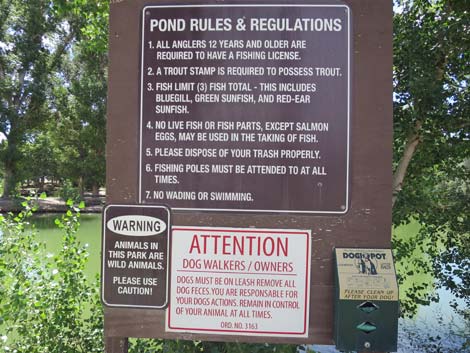 Some rules and regulations |
Beyond the main park area, the lands have been developed as a floodwater retention basin with hiking trails around the edge. This area was used by large prehistoric mammals, and the fossilized remains of several species (e.g., horses, camels, giant sloths, mammoths, and bison) have been found. The area later was used by Native Americans and then by white travelers. The area was "settled" and used for cattle and dude ranching, and the remains of these activities are now protected as the Tule Springs Ranch Historic Area. In 1964, the ranch became public land. Activities in the park include bird watching, fishing, learning about local and prehistoric history, picnicking, and walking. The lakes are open for fishing (stocked with catfish during summer and trout during winter; bass and sunfish all year). Facilities include picnic areas with covered tables and grills, restrooms, group picnic areas, and paved paths that wind through the main park area. |
 Birdwatchers walking under towering cottonwood trees |
Location Floyd Lamb Park at Tule Springs is located in the northwest part of Las Vegas, about 15 miles (20 minutes) from downtown. From downtown, drive north on Highway 95 to Durango Road. Exit the highway and turn right onto Durango. At this point, Durango runs diagonally to the northeast. Follow Durango as it curves to the left (north) and continue for about half-a-mile to Brent Lane. Watch for brown park signs. Turn right onto Brent Lane and drive east into the park (Table 1, Site 0587). Hours The park is open daily. During winter, hours are 9 AM to 5 PM. During summer, hours are 8 AM to 8 PM. The closing time varies during the years, generally matching sunset. Fees Admission costs $6 per vehicle per day. Annual permits are available. |
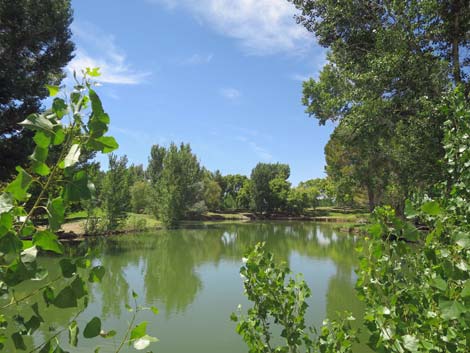 During winter, lakes are covered with waterfowl; not so in summer |
Specialties Check the ponds for domestic and wild waterfowl (various ducks and geese), Double-crested Cormorant, and Pied-billed Grebe; check the tule marshes for Yellow-headed Blackbird, Redwing Blackbird, Marsh Wren, and wading birds (Great Blue Heron, Green Heron); and check the trees and shrubs for black phoebe, warblers, towhees, and sparrows. Owls (Great Horned Owl) can sometimes be seen in the trees, and Greater Roadrunners prowl the picnic areas. Large numbers of sparrows can be found on the mowed lawns around the ponds and on the grassy edges of the ponds. A fair number of peacocks roam the park grounds too. This is also a good place to see dragonflies. During winter, the ponds are good for waterfowl, grebes, and wading birds. In summer, check the trees for sparrows, warblers, flycatchers, and other passerines. Migration is a busy season. Check the trees for migrants, especially eastern migrant warblers, and check the grassy edges for sparrows. Look southeast from the entrance station for Burrowing Owls. |
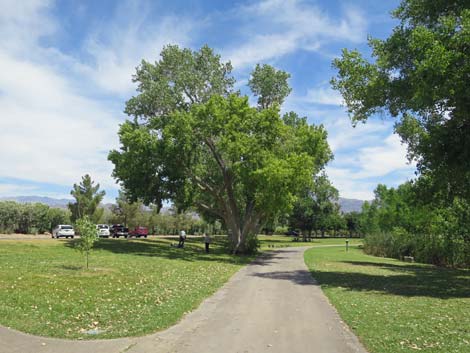 Tree and lawns attract lots of birds (view E) |
With the urban sprawl, the bird mix should change. It will be interesting to see who comes and who goes, but there probably will be fewer desert species as these birds retreat northward ahead of the housing developments. Tule Springs is one of the best Pleistocene paleontology sites in Western North America, so be sure to read the signs and contemplate life we some 20,000 years ago when the environment was wetter than today. For More Information Visit the official park website or write the park at: Floyd Lamb Park, 9200 Tule Springs Road, Las Vegas, NV 89131. Download the park brochure (pdf). |
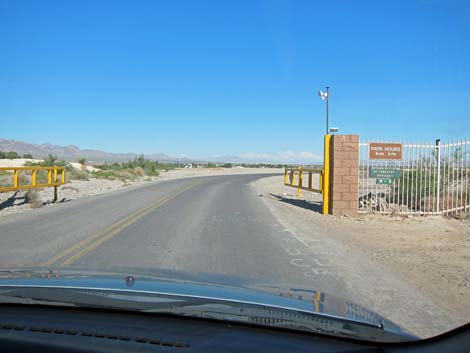 Floyd Lamb Park entrance gate on Brent Lane (view E) |
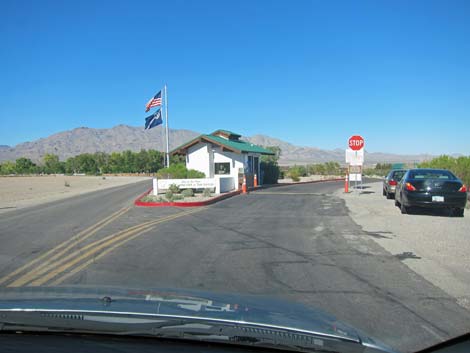 Floyd Lamb Park entrance station; pay fee here (view NE) |
 Birders often use table numbers when referring to bird locations |
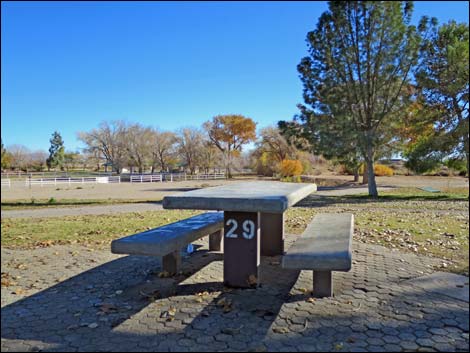 Birders often use table numbers when referring to bird locations |
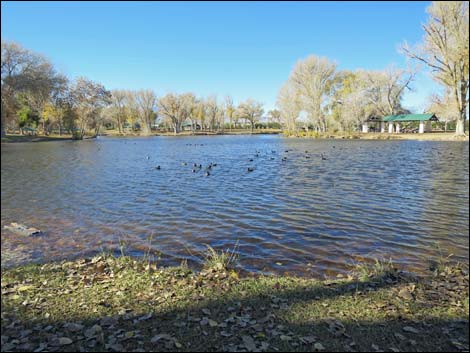 Lots of ducks during winter |
 Lots of ducks during winter |
 Fall colors with snowy Spring Mountains in the background |
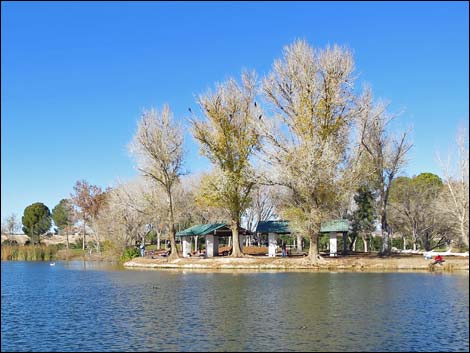 Note black tree ornaments at Christmas: cormorants! |
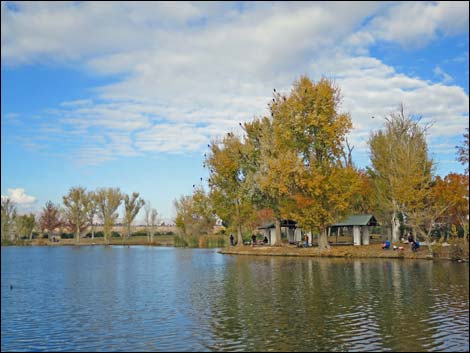 Fall colors at Floyd Lamb |
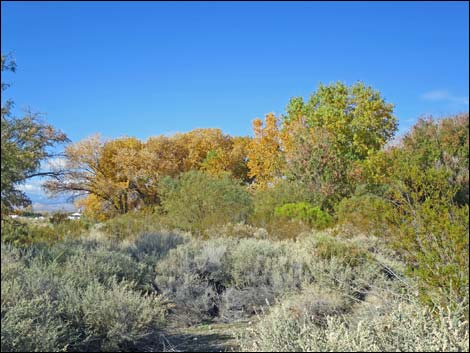 Fall colors at Floyd Lamb |
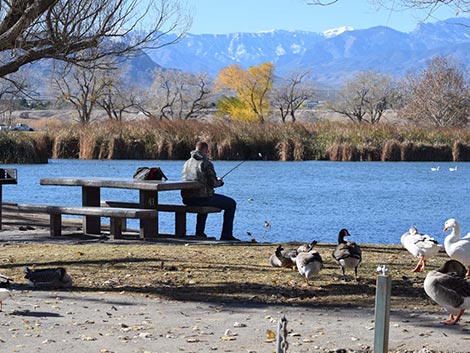 |
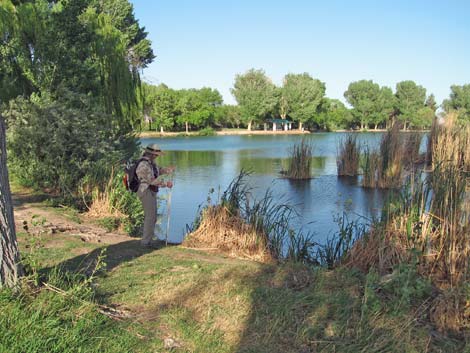 |
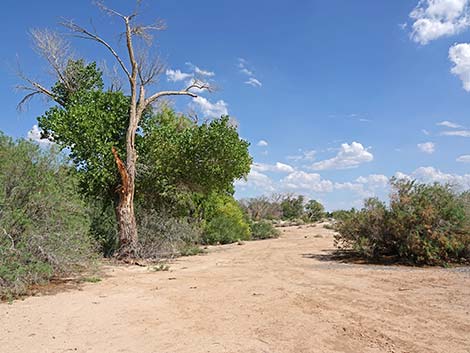 Cottonwood trees and riparian area along the outflow |
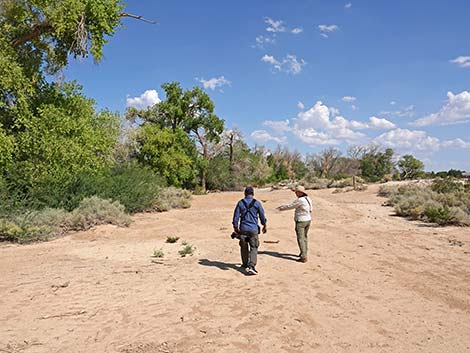 Walking along trees and riparian area along the outflow |
 Walking along trees and riparian along at the outflow |
 Mesquite trees along at the outflow |
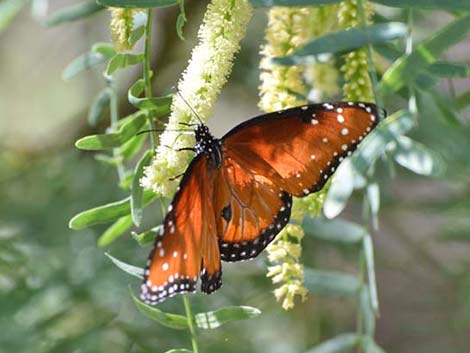 Don't overlook the butterflies: Queen Butterfly |
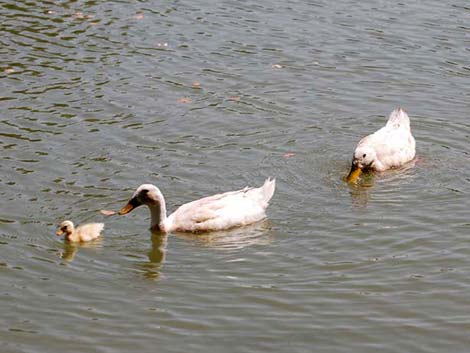 Lots of domestic ducks |
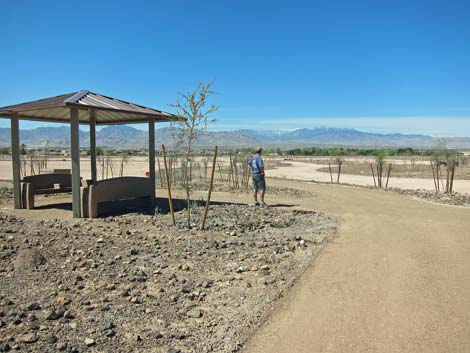 Shade structure along trail in floodwater detention area |
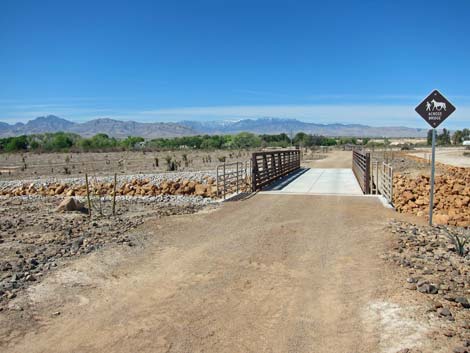 Foot bridge along trail in floodwater detention area |
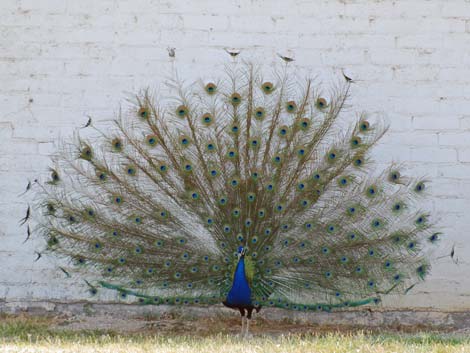 Peacock (Indian Peafowl) |
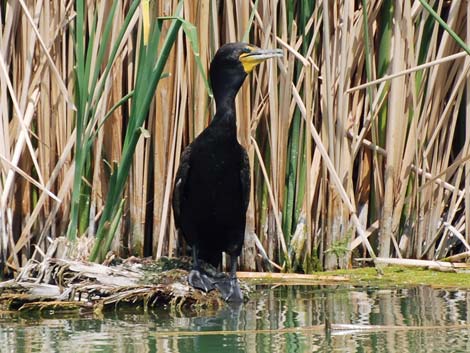 Double-crested Cormorant at Tule Springs Lake |
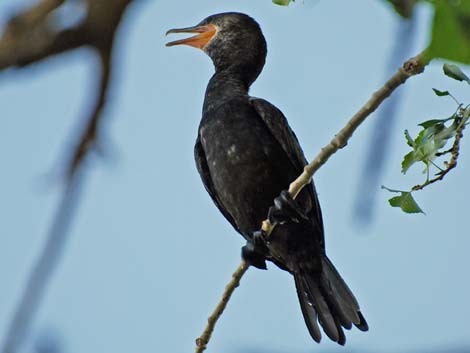 Neotropic Cormorant |
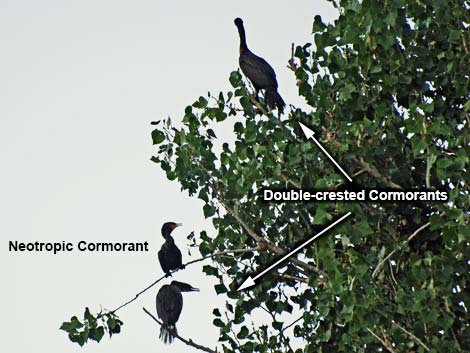 Neotropic Cormorant and two Double-crested Cormorants |
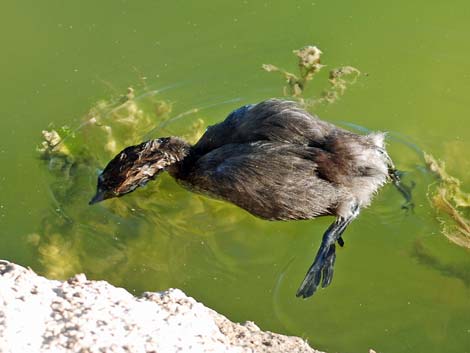 Up close with a juvenile Pied-billed Grebe |
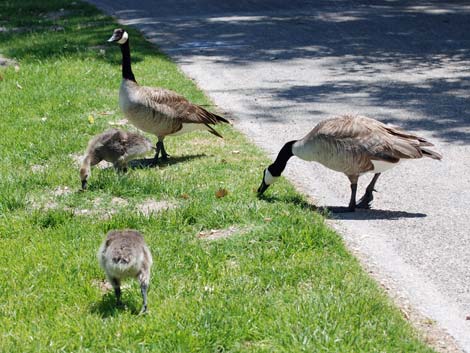 Canada Goose family |
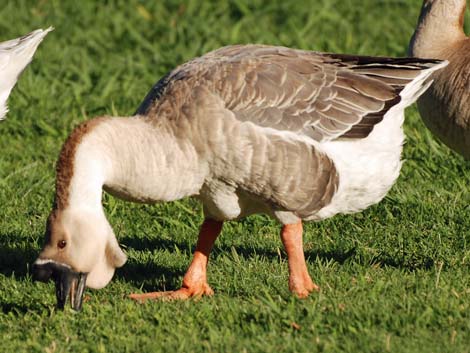 Waddled Chinese Goose |
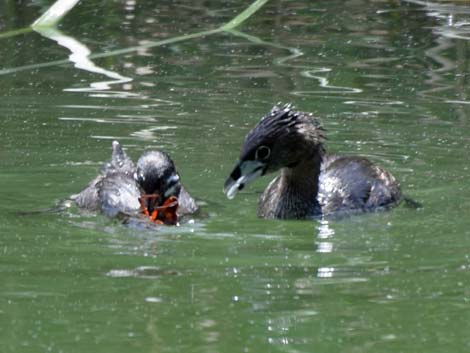 Pied-billed Grebe feeding Red Swamp Crayfish to fledgling |
 Cooper's Hawks nest at Floyd Lamb Park |
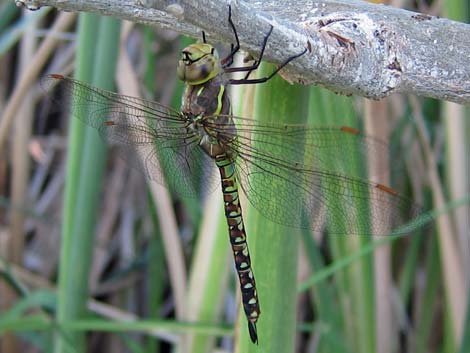 Be sure to watch Dragonflies too! |
Table 1. Highway Coordinates (NAD27; UTM Zone 11S). Download Highway GPS Waypoints (*.gpx) file.
| Site # | Location | Latitude (°N) | Longitude (°W) | UTM Easting | UTM Northing | Elevation (feet) | Verified |
|---|---|---|---|---|---|---|---|
| 0587 | Floyd Lamb Park at Tule Springs | 36.3238 | 115.2664 | 655614 | 4021054 | 2,490 | Yes |
Happy birding! All distances, elevations, and other facts are approximate.
![]() ; Last updated 240323
; Last updated 240323
| Birding Around Las Vegas | Southern Nevada Birds | Guide Services | Copyright, Conditions, Disclaimer | Home |